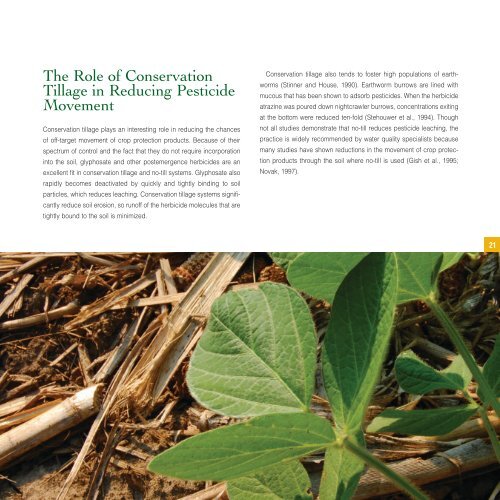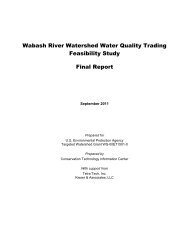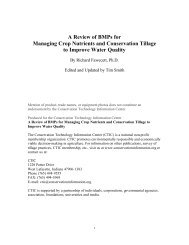Facilitating Conservation Farming Practices and Enhancing ...
Facilitating Conservation Farming Practices and Enhancing ...
Facilitating Conservation Farming Practices and Enhancing ...
You also want an ePaper? Increase the reach of your titles
YUMPU automatically turns print PDFs into web optimized ePapers that Google loves.
The Role of <strong>Conservation</strong><br />
Tillage in Reducing Pesticide<br />
Movement<br />
<strong>Conservation</strong> tillage plays an interesting role in reducing the chances<br />
of off-target movement of crop protection products. Because of their<br />
spectrum of control <strong>and</strong> the fact that they do not require incorporation<br />
into the soil, glyphosate <strong>and</strong> other postemergence herbicides are an<br />
excellent fit in conservation tillage <strong>and</strong> no-till systems. Glyphosate also<br />
rapidly becomes deactivated by quickly <strong>and</strong> tightly binding to soil<br />
particles, which reduces leaching. <strong>Conservation</strong> tillage systems significantly<br />
reduce soil erosion, so runoff of the herbicide molecules that are<br />
tightly bound to the soil is minimized.<br />
<strong>Conservation</strong> tillage also tends to foster high populations of earthworms<br />
(Stinner <strong>and</strong> House, 1990). Earthworm burrows are lined with<br />
mucous that has been shown to adsorb pesticides. When the herbicide<br />
atrazine was poured down nightcrawler burrows, concentrations exiting<br />
at the bottom were reduced ten-fold (Stehouwer et al., 1994). Though<br />
not all studies demonstrate that no-till reduces pesticide leaching, the<br />
practice is widely recommended by water quality specialists because<br />
many studies have shown reductions in the movement of crop protection<br />
products through the soil where no-till is used (Gish et al., 1995;<br />
Novak, 1997).<br />
21








